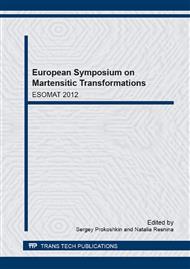p.33
p.38
p.46
p.51
p.56
p.65
p.72
p.77
p.82
Electric Resistivity as Phase Volume Fractions Indicator in Metastable Alloys
Abstract:
The microstructure of metastable alloys varies with the thermomechanical history of the material. During a thermomechanical loading, different phases can be present in the material simultaneously. They can be at the origin of macroscopic stress and strain. Consequently, it is important to determine the proportion of each phase to understand the transformation kinetic. However, the techniques usually used to carry out these measurements such as magnetic properties measurements, neutron or X-ray diffraction, are heavy and require a lot of resources. This study, thanks to experimental tests based on electric resistance measurements, permits to determine the volume fraction of the different states present in the material. The study has been realized on a 301 stainless steel in order to take into account the effects of elasticity, transformation and plasticity. Then the volume fraction of the different phases of the material has been determined during transformation with the plasticity presence.
Info:
Periodical:
Pages:
56-61
Citation:
Online since:
January 2013
Price:
Сopyright:
© 2013 Trans Tech Publications Ltd. All Rights Reserved
Share:
Citation:


